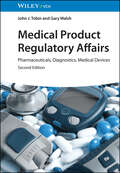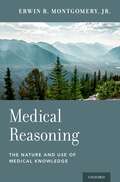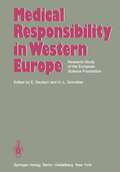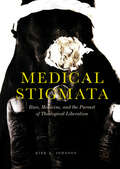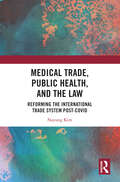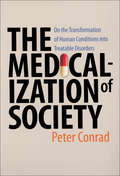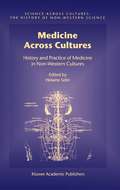- Table View
- List View
Medical Product Regulatory Affairs: Pharmaceuticals, Diagnostics, Medical Devices
by John J. Tobin Gary WalshMedical Product Regulatory Affairs Hands-on guide through the jungle of medical regulatory affairs for every professional involved in bringing new products to market Based on a module prepared by the authors for an MSc course offered by the University of Limerick, Ireland, Medical Product Regulatory Affairs is a comprehensive and practical guide on how pharmaceutical and medical devices are regulated within the major global markets. The Second Edition builds on the success of the first with an even wider scope and full coverage of new EU regulations on the safe use of medical devices. Following a look at drug development, complete sections are devoted to national and EU regulatory issues, manufacturing license application and retention, and regulation in the USA. Other topics dealt with include CDER, CBER and marketing and manufacturing licenses, the ICH process and Good Laboratory/Clinical/ Manufacturing Practices. Medical Product Regulatory Affairs includes information on: Aims and structure of regulation, covering purpose and principles of regulation, national and EU legislative processes, and pharmacopeia Regulatory strategy, covering product development and manufacturing, market vigilance, quality assurance systems, personnel, and documentation Drug discovery and development, covering prescription status, physical properties, therapeutic use, and drug discovery, development, and delivery Non-clinical studies, covering non-clinical study objectives and timing, pharmacological and pharmacodynamic studies, and bioavailability and bioequivalence Clinical trials, covering trial protocol, monitoring of trials, trial master files, and FDA communications The wide coverage of different product types and the main global markets makes Medical Product Regulatory Affairs ideal for training courses on regulatory affairs in academia and industry. It is also a valuable reference for pharmacologists, bioengineers, pharma engineers, and students in pharmacy to familiarize themselves with the topic.
Medical Professionals: Conflicts and Quandaries in Medical Practice (Routledge Studies in Health Management)
by Kathleen Montgomery Wendy LipworthMedical Professionals: Conflicts and Quandaries in Medical Practice offers a fresh approach to understanding the role-related conflicts and quandaries that pervade contemporary medical practice. While a focus on professional conflicts is not new in the literature, what is missing is a volume that delves into medical professionals’ own experience of the conflicts and quandaries they face, often as a result of inhabiting multiple roles. The volume explores the ways in which these conflicts and quandaries are exacerbated by broader societal forces, including changing scientific and technological paradigms, commercialization, and strengthened consumer movements, which simultaneously expand the scope of roles and responsibilities that medical professionals are expected to fulfill, and make it more difficult to do so. Several empirical chapters analyze data from qualitative interview studies with clinicians and other stakeholders. The studies highlight the burdens on clinicians who are expected to make informed and justified judgments and decisions in the midst of competing pressures; authors describe the methods that clinicians use to address the associated tensions within specific contexts. Two conceptual chapters follow and offer some innovative ways to think about the challenges facing medical professionals as they strive to make sense of the changing landscape within healthcare. The first reflects on the challenges to clinical practice in the midst of shifting and often competing definitions of disease and associated ideologies of care. The second reflects more broadly on the utility of value pluralism as a framework for conceptualizing and working through moral and professional quandaries. The book concludes with a chapter containing suggestions for how members of the medical profession might reframe their thinking about their roles, responsibilities, and decision-making in the midst of inevitable quandaries such as those presented here. This book will be of vital reading for academics, researchers, educators, postgraduate students, and interested health care practitioners and administrators.
Medical Professionals: Conflicts and Quandaries in Medical Practice (Routledge Studies in Health Management)
by Kathleen Montgomery Wendy LipworthMedical Professionals: Conflicts and Quandaries in Medical Practice offers a fresh approach to understanding the role-related conflicts and quandaries that pervade contemporary medical practice. While a focus on professional conflicts is not new in the literature, what is missing is a volume that delves into medical professionals’ own experience of the conflicts and quandaries they face, often as a result of inhabiting multiple roles. The volume explores the ways in which these conflicts and quandaries are exacerbated by broader societal forces, including changing scientific and technological paradigms, commercialization, and strengthened consumer movements, which simultaneously expand the scope of roles and responsibilities that medical professionals are expected to fulfill, and make it more difficult to do so. Several empirical chapters analyze data from qualitative interview studies with clinicians and other stakeholders. The studies highlight the burdens on clinicians who are expected to make informed and justified judgments and decisions in the midst of competing pressures; authors describe the methods that clinicians use to address the associated tensions within specific contexts. Two conceptual chapters follow and offer some innovative ways to think about the challenges facing medical professionals as they strive to make sense of the changing landscape within healthcare. The first reflects on the challenges to clinical practice in the midst of shifting and often competing definitions of disease and associated ideologies of care. The second reflects more broadly on the utility of value pluralism as a framework for conceptualizing and working through moral and professional quandaries. The book concludes with a chapter containing suggestions for how members of the medical profession might reframe their thinking about their roles, responsibilities, and decision-making in the midst of inevitable quandaries such as those presented here. This book will be of vital reading for academics, researchers, educators, postgraduate students, and interested health care practitioners and administrators.
Medical Reasoning: The Nature and Use of Medical Knowledge
by Erwin B. MontgomeryModern medicine is one of humankind's greatest achievements.Yet today, frequent medical errors and irreproducibility in biomedical research suggest that tremendous challenges beset it. Understanding these challenges and trying to remedy them have driven considerable and thoughtful critical analyses, but the apparent intransigence of these problems suggests a different perspective is needed. Now more than ever, when we see options and opportunities for healthcare expanding while resources are diminishing, it is extremely important that healthcare professionals practice medicine wisely. In Medical Reasoning, neurologist Erwin B. Montgomery, Jr. offers a new and vital perspective. He begins with the idea that the need for certainty in medical decision-making has been the primary driving force in medical reasoning. Doctors must routinely confront countless manifestations of symptoms, diseases, or behaviors in their patients. Therefore, either there are as many different "diseases" as there are patients or some economical set of principles and facts can be combined to explain each patient's disease. The response to this epistemic conundrum has driven medicine throughout history: the challenge is to discover principles and facts and then to develop means to apply them to each unique patient in a manner that provides certainty. This book studies the nature of medical decision making systematically and rigorously in both an analytic and historical context, addressing medicine's unique need for certainty in the face of the enormous variety of diseases and in the manifestations of the same disease in different patients. The book also examines how the social, legal, and economic circumstances in which medical decision-making occurs greatly influence the nature of medical reasoning. Medical Reasoning is essential for those at the intersection of healthcare and philosophy.
Medical Reasoning: The Nature and Use of Medical Knowledge
by Erwin B. MontgomeryModern medicine is one of humankind's greatest achievements.Yet today, frequent medical errors and irreproducibility in biomedical research suggest that tremendous challenges beset it. Understanding these challenges and trying to remedy them have driven considerable and thoughtful critical analyses, but the apparent intransigence of these problems suggests a different perspective is needed. Now more than ever, when we see options and opportunities for healthcare expanding while resources are diminishing, it is extremely important that healthcare professionals practice medicine wisely. In Medical Reasoning, neurologist Erwin B. Montgomery, Jr. offers a new and vital perspective. He begins with the idea that the need for certainty in medical decision-making has been the primary driving force in medical reasoning. Doctors must routinely confront countless manifestations of symptoms, diseases, or behaviors in their patients. Therefore, either there are as many different "diseases" as there are patients or some economical set of principles and facts can be combined to explain each patient's disease. The response to this epistemic conundrum has driven medicine throughout history: the challenge is to discover principles and facts and then to develop means to apply them to each unique patient in a manner that provides certainty. This book studies the nature of medical decision making systematically and rigorously in both an analytic and historical context, addressing medicine's unique need for certainty in the face of the enormous variety of diseases and in the manifestations of the same disease in different patients. The book also examines how the social, legal, and economic circumstances in which medical decision-making occurs greatly influence the nature of medical reasoning. Medical Reasoning is essential for those at the intersection of healthcare and philosophy.
Medical Records Use and Abuse
by Heidi Tranberg Jem Rashbass‘This book provides the background and practical guidance for all those of us who face challenges for the way we handle medical records. Written by a lawyer and a clinical informatician it provides the fusion between the legal issues and the practical clinical ones. There are clear explanations of the current legal framework, set in the context of real-world applications; the more complex issues that have a significant impact on Policy are also dealt with in depth. The background to ‘consent’ and the impact that implied and explicit consent can have on the way records are collect and used is particularly well covered. This book has many audiences, all of whom will gain from the easily accessible information within it. Caldicott guardians, research ethics committee members, and all those researchers and clinicians who need to analyze patient information will have a particular need for this handbook. Patients and the public should use it to understand how their healthcare information is protected and used. Its arrival could not have come at a better time’ Sir John Pattison, Former Director of Research, Analysis and Information, Department of Health, England.
Medical Records Use and Abuse
by Heidi Tranberg Jem Rashbass‘This book provides the background and practical guidance for all those of us who face challenges for the way we handle medical records. Written by a lawyer and a clinical informatician it provides the fusion between the legal issues and the practical clinical ones. There are clear explanations of the current legal framework, set in the context of real-world applications; the more complex issues that have a significant impact on Policy are also dealt with in depth. The background to ‘consent’ and the impact that implied and explicit consent can have on the way records are collect and used is particularly well covered. This book has many audiences, all of whom will gain from the easily accessible information within it. Caldicott guardians, research ethics committee members, and all those researchers and clinicians who need to analyze patient information will have a particular need for this handbook. Patients and the public should use it to understand how their healthcare information is protected and used. Its arrival could not have come at a better time’ Sir John Pattison, Former Director of Research, Analysis and Information, Department of Health, England.
Medical Research Ethics: Challenges in the 21st Century (Philosophy and Medicine #132)
by Tomas Zima David N. WeisstubThis book provides a current review of Medical Research Ethics on a global basis. The book contains chapters that are historically and philosophically reflective and aimed to promote a discussion about controversial and foundational aspects in the field. An elaborate group of chapters concentrates on key areas of medical research where there are core ethical issues that arise both in theory and practice: genetics, neuroscience, surgery, palliative care, diagnostics, risk and prediction, security, pandemic threats, finances, technology, and public policy.This book is suitable for use from the most basic introductory courses to the highest levels of expertise in multidisciplinary contexts. The insights and research by this group of top scholars in the field of bioethics is an indispensable read for medical students in bioethics seminars and courses as well as for philosophy of bioethics classes in departments of philosophy, nursing faculties, law schools where bioethics is linked to medical law, experts in comparative law and public health, international human rights, and is equally useful for policy planning in pharmaceutical companies.
Medical Responsibility in Western Europe: Research Study of the European Science Foundation
by J. Blackie J. Santos Briz F. Busnelli R. O. Dalcq E. Deutsch J. de Figueiredo Dias N. S. Fotakis H. Hausheer J. Hellner I. Kennedy H.J.J. Leenen P. Lodrup J. Sinde Monteiro J. Penneau J. Radisic H. L. Schreiber J. W. Steiner M. ZanaWith contributions by numerous experts
Medical Self-Regulation: Crisis and Change (Medical Law and Ethics)
by Mark DaviesSelf-regulation constitutes an important aspect of the regulatory and oversight process governing professionals. This book focuses directly on medical self-regulation in the context of both the wider regulatory framework and that of other regulatory models. Through a critical consideration of recent events, including high-profile and controversial cases, it is demonstrated that the self-regulatory process has failed and that only fundamental restructuring and a radical change in attitudes on the part of members of the profession can repair the damage. Attention is also given to the recent changes, current proposals for change and to alternative regulatory models. Medical Self-Regulation will be of international interest, appealing to policy makers, as well as students and practitioners in the fields of medicine, medical law and sociology and professional regulation.
Medical Self-Regulation: Crisis and Change (Medical Law and Ethics)
by Mark DaviesSelf-regulation constitutes an important aspect of the regulatory and oversight process governing professionals. This book focuses directly on medical self-regulation in the context of both the wider regulatory framework and that of other regulatory models. Through a critical consideration of recent events, including high-profile and controversial cases, it is demonstrated that the self-regulatory process has failed and that only fundamental restructuring and a radical change in attitudes on the part of members of the profession can repair the damage. Attention is also given to the recent changes, current proposals for change and to alternative regulatory models. Medical Self-Regulation will be of international interest, appealing to policy makers, as well as students and practitioners in the fields of medicine, medical law and sociology and professional regulation.
Medical Stigmata: Race, Medicine, and the Pursuit of Theological Liberation
by Kirk A. JohnsonThis book observes the idea of race as a false representation for the cause of disease. Race-based medicine, an emerging field in pharmacology, aims to create a specialty market based on racial groups. Within this market, the drug BiDil set a precedent in this area of medicine targeting African Americans as its first racial group. Consequently, selecting African Americans as a “starter group” led to ethical questions regarding the motive behind race-based medicine within the context of the larger treatment of blacks in American medical history. This book therefore links medicine and American eugenics, examines race-based medicine’s influence on the perception of the black body, traces the influence of BiDil’s approval on the resurgence of race-based medicine, and assesses the black church’s response to race-based medicine using black liberation theology as a means to social justice.
Medical Technologies in Neurosurgery (Acta Neurochirurgica Supplement #98)
by Christopher Nimsky Rudolf FahlbuschThis Acta Neurochirurica supplement distills the accomplishments of the Joint Convention of the Academia Eurasania Nuerochirurgica and the German Academy of Neurosurgery held in Bamberg, Germany from Sept. 1-3 2005. The main focus is "Medical Technologies for Neurosurgery," including: imaging, image processing, robotics, workflow analysis and ethics. Coverage extends from an overview of medical technologies, to robotic-assisted systems in neurosurgical operating rooms, to intraoperative MRI.
Medical Trade, Public Health, and the Law: Reforming the International Trade System Post-Covid
by Nayung KimFaced with evolving trade and health dynamics, this book presents a historical, conceptual, and empirical examination of public health and medical procurement in international trade law at a time of emergency. The work argues that the current trade framework is outdated and must be redesigned to suit the new needs of the 21st century. It identifies critical problems within the current international trade system that prevents it from effectively responding to pandemics, as well as to the emerging digital economy. Based on the analysis, the study puts forward specific suggestions to upgrade the current trade rules framework to prepare for future international public health emergencies and further digitalization of health services. The book will be a valuable resource for academics, researchers and policy-makers working in the areas of International Trade Law, Public Health Law and Medical Law.
Medical Trade, Public Health, and the Law: Reforming the International Trade System Post-Covid
by Nayung KimFaced with evolving trade and health dynamics, this book presents a historical, conceptual, and empirical examination of public health and medical procurement in international trade law at a time of emergency. The work argues that the current trade framework is outdated and must be redesigned to suit the new needs of the 21st century. It identifies critical problems within the current international trade system that prevents it from effectively responding to pandemics, as well as to the emerging digital economy. Based on the analysis, the study puts forward specific suggestions to upgrade the current trade rules framework to prepare for future international public health emergencies and further digitalization of health services. The book will be a valuable resource for academics, researchers and policy-makers working in the areas of International Trade Law, Public Health Law and Medical Law.
Medical Treatment: Decisions and the Law
by Christopher Johnston Sophia RoperThis leading textbook places medical decision-making in its legal context and provides practical guidance on the most ethically challenging cases that face the courts. It explains how the Mental Capacity Act works in practice and how the courts and lawyers wrestle with and resolve problems relating to the very essence of life: what is life? what is an acceptable quality of life? what treatment is so burdensome that it should not be attempted? These questions are posed, not in the abstract but, in real – often desperate, often urgent – situations.This is the essential guide for solicitors, barristers and judges specialising in Court of Protection work, clinical negligence, personal injury and human rights. Postgraduate medical ethics students and academics, NHS bodies and local authority professionals, health professionals and administrators in the NHS and private practice and those in Commonwealth countries with an interest in these topics will also find this book an invaluable resource. Medical Treatment: Decisions and the Law offers a readily accessible text for those dealing with the provision of medical treatment to those without capacity and related areas, providing a clear description of procedure as well as practical application of the law. Key developments for the Fourth Edition include:· The impact of the Covid-19 pandemic on decision making in the Court of Protection, particularly in relation to end of life decisions and vaccination· New chapters on two controversial issues: “the Right to Die?” and “Access to Healthcare: Choice”· Expanded chapter on Decisions for Children, covering recent high-profile cases such as Re Gard where continued provision of life sustaining treatment for babies or very young infants was at issue, and addressing the difficult issues around decision making by 16 to 17 year olds· Substantially updated chapter on Going to Court, covering how the incapacitous patient can be supported to participate in decisions about their treatmentDiscussion of “Escalation of Care” covering matters including NICE guidelines and care pathways and expanded coverage of issues concerning the funding of treatment.
Medical Use of Human Beings: Respect as a Basis for Critique of Discourse, Law and Practice (Biomedical Law and Ethics Library)
by Austen Garwood-GowersWhilst activities like transplantation and medical research have typically been considered on a discrete basis, they are also actually part of a broader phenomenon of medical means being employed to make use of human beings. This book is the first ever systematic critique of such medical use of the human being as a whole. It is divided into two parts. The first part considers what constitutes an appropriate normative lens through which to view such medical use and its constraint. It makes a reasoned ethical and human-rights-based case for preferring respect for human worth over any of the main alternative approaches that have been drawn on in specific contexts and outlines what this preference practically implies. The second part uses this respect-based lens to critique use discourse, law and practice. Drawing on three contrasting case study areas of warfare-related medical use, transplantation and human tissue research, this book exposes both the context-specific and thematic nature of shortfalls in respect. Overall this book provides a compelling analysis of how medical use ought to be constrained and a compelling critique of the excesses of discourse, practice and governance. It is recommended to academics, students, policymakers and professionals whose work is focused on or intersects with the medical sector and anyone else with an interest in medicine and its limits.
Medical Use of Human Beings: Respect as a Basis for Critique of Discourse, Law and Practice (Biomedical Law and Ethics Library)
by Austen Garwood-GowersWhilst activities like transplantation and medical research have typically been considered on a discrete basis, they are also actually part of a broader phenomenon of medical means being employed to make use of human beings. This book is the first ever systematic critique of such medical use of the human being as a whole. It is divided into two parts. The first part considers what constitutes an appropriate normative lens through which to view such medical use and its constraint. It makes a reasoned ethical and human-rights-based case for preferring respect for human worth over any of the main alternative approaches that have been drawn on in specific contexts and outlines what this preference practically implies. The second part uses this respect-based lens to critique use discourse, law and practice. Drawing on three contrasting case study areas of warfare-related medical use, transplantation and human tissue research, this book exposes both the context-specific and thematic nature of shortfalls in respect. Overall this book provides a compelling analysis of how medical use ought to be constrained and a compelling critique of the excesses of discourse, practice and governance. It is recommended to academics, students, policymakers and professionals whose work is focused on or intersects with the medical sector and anyone else with an interest in medicine and its limits.
The Medicalization of Society: On the Transformation of Human Conditions into Treatable Disorders
by Peter ConradOver the past half-century, the social terrain of health and illness has been transformed. What were once considered normal human events and common human problems—birth, aging, menopause, alcoholism, and obesity—are now viewed as medical conditions. For better or worse, medicine increasingly permeates aspects of daily life.Building on more than three decades of research, Peter Conrad explores the changing forces behind this trend with case studies of short stature, social anxiety, "male menopause," erectile dysfunction, adult ADHD, and sexual orientation. He examines the emergence of and changes in medicalization, the consequences of the expanding medical domain, and the implications for health and society. He finds in recent developments—such as the growing number of possible diagnoses and biomedical enhancements—the future direction of medicalization. Conrad contends that the impact of medical professionals on medicalization has diminished. Instead, the pharmaceutical and biotechnical industries, insurance companies and HMOs, and the patient as consumer have become the major forces promoting medicalization. This thought-provoking study offers valuable insight into not only how medicalization got to this point but also how it may continue to evolve.
Medicinal Product Liability and Regulation
by Richard GoldbergThe piecemeal developments in product liability reform in Europe have their origins in the tragic association of phocomelia in children with thalidomide in 1962. In many ways these events have continued to generate pressure for reform of product liability, especially for the victims of drug-induced injury. This monograph attempts to address the major problems that typify claims for drug-induced injury, as well as highlighting the complex interrelationship between liability exposure and drug regulation.While medicinal products are subject to strict liability under the product liability directive, the claimant may have considerable difficulty in establishing that the relevant product is defective and that it caused the damage. It may also be necessary to overcome the development risk defence where this is pleaded. The monograph addresses these problems on a comparative jurisprudential basis, and seeks to determine whether medicinal products should be treated as a special case in the field of product liability. It examines the role of epidemiological evidence in assessing causation in product liability cases concerning medicinal products in the light of recent developments in the UK Supreme Court, the United States, Canada and France. In particular, it addresses the difficulties in reconciling the standards of proof in law and science, including the theory that causation can be proved on the balance of probabilities by reference to the doubling of risk of injury. An important case study compares and contrasts the approaches of the UK and the US to the measles, mumps, rubella Litigation.The book also examines the question as to whether compliance with regulatory standards should protect pharmaceutical manufacturers from product liability suits. It seeks to support a via media whereby the victims of drug induced injury can receive justice, while at the same time encouraging drug safety and innovation in drug development.
Medicinal Product Liability and Regulation
by Richard GoldbergThe piecemeal developments in product liability reform in Europe have their origins in the tragic association of phocomelia in children with thalidomide in 1962. In many ways these events have continued to generate pressure for reform of product liability, especially for the victims of drug-induced injury. This monograph attempts to address the major problems that typify claims for drug-induced injury, as well as highlighting the complex interrelationship between liability exposure and drug regulation.While medicinal products are subject to strict liability under the product liability directive, the claimant may have considerable difficulty in establishing that the relevant product is defective and that it caused the damage. It may also be necessary to overcome the development risk defence where this is pleaded. The monograph addresses these problems on a comparative jurisprudential basis, and seeks to determine whether medicinal products should be treated as a special case in the field of product liability. It examines the role of epidemiological evidence in assessing causation in product liability cases concerning medicinal products in the light of recent developments in the UK Supreme Court, the United States, Canada and France. In particular, it addresses the difficulties in reconciling the standards of proof in law and science, including the theory that causation can be proved on the balance of probabilities by reference to the doubling of risk of injury. An important case study compares and contrasts the approaches of the UK and the US to the measles, mumps, rubella Litigation.The book also examines the question as to whether compliance with regulatory standards should protect pharmaceutical manufacturers from product liability suits. It seeks to support a via media whereby the victims of drug induced injury can receive justice, while at the same time encouraging drug safety and innovation in drug development.
Medicine Across Cultures: History and Practice of Medicine in Non-Western Cultures (Science Across Cultures: The History of Non-Western Science #3)
by Hugh ShapiroThis work deals with the medical knowledge and beliefs of cultures outside of the United States and Europe. In addition to articles surveying Islamic, Chinese, Native American, Aboriginal Australian, Indian, Egyptian, and Tibetan medicine, the book includes essays on comparing Chinese and western medicine and religion and medicine. Each essay is well illustrated and contains an extensive bibliography.
Medicine And The Ethics Of Care (Moral Traditions)
by Diana Cates Paul LauritzenIn these essays, a diverse group of ethicists draw insights from both religious and feminist scholarship in order to propose creative new approaches to the ethics of medical care. While traditional ethics emphasizes rules, justice, and fairness, the contributors to this volume embrace an "ethics of care", which regards emotional engagement in the lives of others as basic to discerning what we ought to do on their behalf. The essays reflect on the three related themes: community, narrative, and emotion. They argue for the need to understand patients and caregivers alike as moral agents who are embedded in multiple communities, who seek to attain or promote healing partly through the medium of storytelling, and who do so by cultivating good emotional habits. A thought-provoking contribution to a field that has long been dominated by an ethics of principle, "Medicine and the Ethics of Care" will appeal to scholars and students who want to move beyond the constraints of that traditional approach.
Medicine and Hope: A Natural Theology of Human Caretaking (Philosophy and Medicine #149)
by Richard SherlockThis book expands, in a modest way, the discussion of hope and does so by focusing on a field where it is at the core of care-taking: medicine. The three great religious virtues of medieval theology were faith, hope, and love. An enormous literature exists about faith and love, but much less exists about hope. Doctors often know what they want to do for a patient but do not know whether they are able to have a good result. If they fail, will the result be worse? They must hope they can succeed. In other cases, they know what they can do but they are uncertain whether they should. If they do not undertake action, will the patient try to do it themselves with a much worse result? Questions such as these raise the issue of the importance of hope in medicine. This book builds on an insight from the first modern textbook of medical ethics, Thomas Percival’s 1803 classic Medical Ethics. There Percival says that the doctor is a “minister of hope to the sick”. This book analyses this concept, which is central to the practice of medicine.
Medicine and Moral Philosophy: A "Philosophy and Public Affairs" Reader
by Marshall CohenResponding to the increased public interest in the moral aspects of medical practice, this collection of essays focuses on questions of justice and injustice in the delivery and distribution of medical care and on problems concerning the rights of patients in their relationship to doctors, medical institutions, and government.Originally published in 1982.The Princeton Legacy Library uses the latest print-on-demand technology to again make available previously out-of-print books from the distinguished backlist of Princeton University Press. These editions preserve the original texts of these important books while presenting them in durable paperback and hardcover editions. The goal of the Princeton Legacy Library is to vastly increase access to the rich scholarly heritage found in the thousands of books published by Princeton University Press since its founding in 1905.
